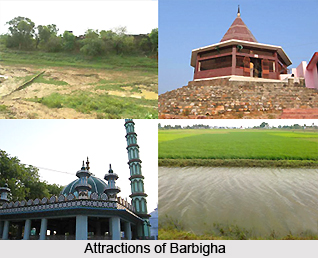 Barbigha is a city as well as a notified area in Bihar. The state of Bihar has in all thirty-seven districts. One of them is the Sheikhpura district. Barbigha is the biggest town market of the Sheikhpura district. It serves as a commercial market of the surrounding villages as well. The blocks in the district are Ariari, Barbigha, Ghatkusumba, Sheikpura, Chebara and Shekhopur Sarai. There are 19 police stations and 54 panchayets in the district.
Barbigha is a city as well as a notified area in Bihar. The state of Bihar has in all thirty-seven districts. One of them is the Sheikhpura district. Barbigha is the biggest town market of the Sheikhpura district. It serves as a commercial market of the surrounding villages as well. The blocks in the district are Ariari, Barbigha, Ghatkusumba, Sheikpura, Chebara and Shekhopur Sarai. There are 19 police stations and 54 panchayets in the district.
Etymology of Barbigha
The term Barbigha is derived from the Hindi phrase: Barah Bigha. Barah Bigha means "Twelve Bigha".
Location of Barbigha
The city is located in Sheikhpura district in the Bihar state of India. The administrative headquarters of this district are located in the town of Sheikhpura. The district is included under the Munger Division. It covers a total area of 689 Square kms.
Demography of Barbigha
As per the 2001 India census, Barbigha has a population of 38,258. Males comprise 53% of the population and females make up 47%. Barbigha has a mean literacy rate of 52%, lower than the nationwide standard of 59.5%. 63% of the males and 37% of the females are literate. 19% of the population constitutes children beneath the age of six years.
Attractions of Barbigha
The land of Barbigha is enveloped by amazing natural beauty. It is home to different crops and rivers. The crops cultivated in the district are paddy, wheat and lentils. The main rivers flowing through the region are the Ganges, the Mohane, the Harohar and the Kiul River.
The closest tourism destinations to Bar Bigha comprise of Bihar Sharif, Pawapuri, Nalanda and Rajgir. Bihar Sharif is the district headquarters of Nalanda district in the state of Bihar. Pawapuri is also located in the Nalanda district. It is a holy site for Jains. Nalanda was a religious centre of learning from the fifth century AD to 1197 AD. It attracted students from varied places like Tibet, China, Greece, and Greater Iran. Rajgir is a notable city in the Nalanda district. It is popular among the tourists due to its hot water springs, locally known as Brahmakund.
Connectivity of Barbigha
The closest railway station is Biharsharif which is situated at a distance of 11.6 kilometres. The nearest airport to Barbigha is at Patna which is at a distance of 77 kilometres.



















